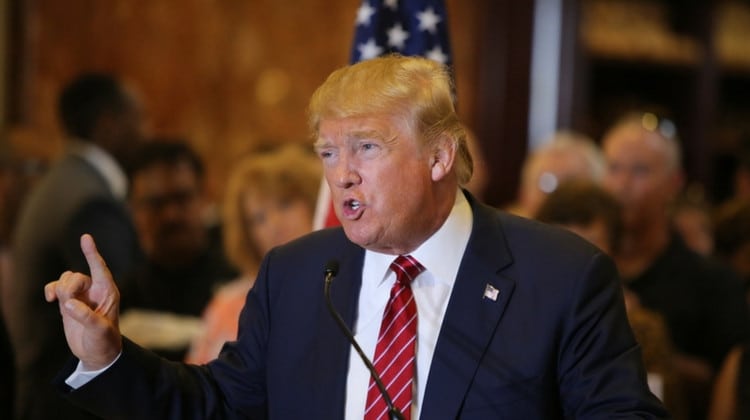government
Trump’s Tax Reform Plan Benefits All Classes — But Has One Major Hurdle…

Fresh on the heels of scrapping his America First Health Plan, President Trump is turning his attention to his promised tax reform. But after finding resistance from not only the Democrats, but his own party, as well, will Trump change his strategy? While there is as yet no official look into Trump’s tax reform plan, based on his campaign promises and actions thus far in office, we can make some educated predictions.
What Can We Expect from Trump’s Tax Reform Plan?
After his health plan fiasco, Trump is looking to work more closely with not only those within his own party, but with Democrats, too, in order to get his tax plan passed. The GOP has always been looked at as a collective of rich white men. So with Trump honing his tax plan to more closely reflect the GOP’s platform, it should come as no surprise that the group to benefit the most from the next tax reform would be the ultra wealthy, and corporations.

Trump’s plan looks to consolidate the current seven income brackets into three, with cuts for income taxes to all. Single taxpayer thresholds will be half of joint filers, getting rid of the marriage penalty, with head-of-household filing status thrown out, as well.
Standard deduction amounts would more than double from current levels, but personal exemptions would be eliminated. Another plus comes for families. Taxpayers would see a larger allowable deduction for child care costs — regardless of whether those expenses are itemized or not — for up to four children, whereas current tax law allows for just two children. Additionally, the lowest tax bracket would see even more childcare benefits for taxes.
But the biggest break would be for the wealthy, who would at long last be free of the estate tax, which taxes money passed down through inheritance even after being taxed when earned. That tax only applies to estates worth more than $5.45 million, meaning that savings would be massive.
But the biggest winner would be corporations.

The goal of Trump’s corporate tax cuts would be to give businesses more money to invest back into their business and, in theory, create more jobs. As such, Trump wants to more than halve the top corporate tax rate from 35% to 15%. In addition, any overseas funds could be brought back into the country one time with a 10% “repatriation” tax.
And while all of that sounds great to taxpayers, there’s one big issue — who will cover the lost funds?
Tax dollars go into effect for public programs and projects, such as veterans benefits, transportation, unemployment, and Medicaid. Those dollars also pay for defense spending. And since Trump is asking for a $54 billion increase in military spending, that makes reducing taxes across the board a puzzle.
For programs and spending taxes don’t cover, the government borrows from other countries. So with nothing but cuts, paired with increased government spending, the U.S. debt could grow significantly. In fact, according to the Committee for a Responsible Federal Budget, the reform would cost $10-12 trillion in lost revenue over 10 years.
Watch this video from PBS News Hour to know more about Trump's tax reform plan:
Some of Trump’s plan should pass without any problems, such as consolidating the tax brackets. However, a lot of the plan, specifically the corporate tax rate, will need to be compromised for this plan to get passed. But tax reform is a significantly less controversial topic than health reform, meaning that if Trump works with lawmakers, he has an opportunity to affect tax reform change for years to come.
Kansas Medicaid Expansion has been approved. Find out more here.
Follow us on Facebook and Twitter for more news updates!
The statements, views, and opinions of any article, contribution, editorial, or advertisement in this publication are not necessarily those of The Capitalist or its editorial staff, and are not considered an endorsement, sponsorship, or recommendation of any referenced product, service, issuer, or groups of issuers.
This publication provides general information about certain subjects, and should not be construed or taken as advice (legal, financial, investment, tax, or otherwise). Do not construe or take any information in this publication as a solicitation, offer, opinion, or recommendation to buy or sell any securities, bonds, or other financial instruments or to provide any legal, financial, investment, tax, or other advice or service about the suitability or profitability of any financial instruments or investments.
The Capitalist disclaims any liability for the accuracy of or your reliance on any statements, views, opinions, or information in this publication.
Featured image via a katz / Shutterstock.com
-
The last couple decades has seen the continued fall of democracy. You can’t get elected very easily on a platform of hard work for all. It’s much easier to promise milk and honey to the multitudes. The result long term is fiscal collapse unless our leaders are willing to….lead.
-
Cutting the Corporate tax rate to 15% would be a windfall. Why do you think companies move out – its the taxes, stupid. And they take their jobs with them. If more people are employed, less are on welfare, and more taxes are collected. But the key is less are on welfare. And with welfare benefits being cut to those that are just to damn lazy to work, I think that is a plus.
As for the inheritance tax, part of the problem is it applies to farmers who have handed down thru generations their farms. A 6 million dollar farm in land takes a lot of work to produce – it’s why a lot of smaller farms have dissappeared…could not afford the taxes.




Pingback: OPEC Renewal Puts U.S. Oil on the Rise | The Capitalist